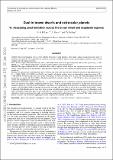Files in this item
Dust in brown dwarfs and extra-solar planets : VI. Assessing seed formation across the brown dwarf and exoplanet regimes
Item metadata
| dc.contributor.author | Lee, Graham K. H. | |
| dc.contributor.author | Blecic, Jasmina | |
| dc.contributor.author | Helling, Christiane | |
| dc.date.accessioned | 2018-06-13T14:30:07Z | |
| dc.date.available | 2018-06-13T14:30:07Z | |
| dc.date.issued | 2018 | |
| dc.identifier.citation | Lee , G K H , Blecic , J & Helling , C 2018 , ' Dust in brown dwarfs and extra-solar planets : VI. Assessing seed formation across the brown dwarf and exoplanet regimes ' , Astronomy & Astrophysics , vol. 614 , A126 . https://doi.org/10.1051/0004-6361/201731977 | en |
| dc.identifier.issn | 0004-6361 | |
| dc.identifier.other | PURE: 253355395 | |
| dc.identifier.other | PURE UUID: b478da61-7b95-4540-b194-05e9a8ab6559 | |
| dc.identifier.other | ArXiv: http://arxiv.org/abs/1801.08482v1 | |
| dc.identifier.other | Scopus: 85049617709 | |
| dc.identifier.other | WOS: 000438804900001 | |
| dc.identifier.uri | https://hdl.handle.net/10023/14019 | |
| dc.description | GKHL and ChH highlight the financial support of the European community under the FP7 ERC starting grant 257431. | en |
| dc.description.abstract | Context. The cloud formation process starts with the formation of seed particles, after which, surface chemical reactions grow or erode the cloud particles. If seed particles do not form, or are not available by another means, an atmosphere is unable to form a cloud complex and will remain cloud free. Aims. We aim to investigate which materials may form cloud condensation seeds in the gas temperature and pressure regimes (Tgas = 100-2000 K, pgas = 10− 8 -100 bar) expected to occur in planetary and brown dwarf atmospheres. Methods. We have applied modified classical nucleation theory which requires surface tensions and vapour pressure data for each solid species, which are taken from the literature. Input gas phase number densities are calculated assuming chemical equilibrium at solar metallicity. Results. We calculated the seed formation rates of TiO2[s] and SiO[s] and find that they efficiently nucleate at high temperatures of Tgas = 1000-1750 K. Cr[s], KCl[s] and NaCl[s] are found to efficiently nucleate across an intermediate temperature range of Tgas = 500-1000 K. We find CsCl[s] may serve as the seed particle for the water cloud layers in cool sub-stellar atmospheres. The nucleation rates of four low temperature ice species (Tgas = 100-250 K), H2O[s/l], NH3[s], H2S[s/l], and CH4[s], are also investigated for the coolest sub-stellar and planetary atmospheres. Conclusions. Our results suggest a possibly (Tgas , pgas ) distributed hierarchy of seed particle formation regimes throughout the sub- stellar and planetary atmospheric temperature-pressure space. With TiO2[s] providing seed particles for the most refractory cloud formation species (e.g. Al2O3[s], Fe[s], MgSiO3[s], Mg2SiO4[s]), Cr[s] providing the seed particles for MnS[s], Na2S[s], and ZnS[s] sulfides, and K/Na/Rb/Cs/NH4-Cl binding solid species providing the seed particles for H2O[s / l] and NH4-H2PO4/SH[s] clouds. A detached, high-altitude aerosol layer may form in some sub-stellar atmospheres from the nucleation process, dependent on the upper atmosphere temperature, pressure and availability of volatile elements. In order to improve the accuracy of the nucleation rate calculation, further research into the small cluster thermochemical data for each cloud species is warranted. The validity of these seed particle scenarios will be tested by applying it to more complete cloud models in the future. | |
| dc.format.extent | 19 | |
| dc.language.iso | eng | |
| dc.relation.ispartof | Astronomy & Astrophysics | en |
| dc.rights | © 2018, ESO. This work has been made available online in accordance with the publisher’s policies. This is the author created, accepted version manuscript following peer review and may differ slightly from the final published version. The final published version of this work is available at https://doi.org/10.1051/0004-6361/201731977 | en |
| dc.subject | Planets and satellites: atmospheres | en |
| dc.subject | Stars: atmospheres | en |
| dc.subject | Stars; brown dwarfs | en |
| dc.subject | Methods: numerical | en |
| dc.subject | QB Astronomy | en |
| dc.subject | QC Physics | en |
| dc.subject | NDAS | en |
| dc.subject.lcc | QB | en |
| dc.subject.lcc | QC | en |
| dc.title | Dust in brown dwarfs and extra-solar planets : VI. Assessing seed formation across the brown dwarf and exoplanet regimes | en |
| dc.type | Journal article | en |
| dc.contributor.sponsor | European Research Council | en |
| dc.description.version | Postprint | en |
| dc.contributor.institution | University of St Andrews. St Andrews Centre for Exoplanet Science | en |
| dc.contributor.institution | University of St Andrews. School of Physics and Astronomy | en |
| dc.identifier.doi | https://doi.org/10.1051/0004-6361/201731977 | |
| dc.description.status | Peer reviewed | en |
| dc.identifier.url | https://arxiv.org/abs/1801.08482 | en |
| dc.identifier.grantnumber | 257431 257431 | en |
This item appears in the following Collection(s)
Items in the St Andrews Research Repository are protected by copyright, with all rights reserved, unless otherwise indicated.

